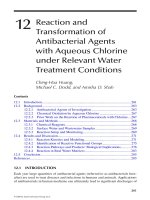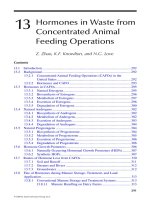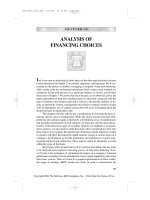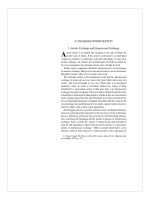Dynamic and Mobile GIS: Investigating Changes in Space and Time - Chapter 10 pot
Bạn đang xem bản rút gọn của tài liệu. Xem và tải ngay bản đầy đủ của tài liệu tại đây (379.06 KB, 12 trang )
____________________________________________________________________________________
Dynamic and Mobile GIS: Investigating Changes in Space and Time. Edited by Jane Drummond, Roland
Billen, Elsa João and David Forrest. © 2006 Taylor & Francis
Chapter 10
Map Matching for Vehicle Guidance
Britta Hummel
University of Karlsruhe, Germany
10.1 Introduction
The past years have revealed a dramatically increasing interest in the use of mobile
Geographical Information Systems (GIS) in various automotive applications. Car
navigation systems employ digital maps to guide the driver to the desired
destination. Next-generation driver assistance systems will use enhanced maps in
order to present precise navigation hints (including speed limits, locations of gas
stations, restaurants, etc.), and for assisted vehicle control. Furthermore, methods
for autonomous enhancements of existing maps using video and lidar sensors are
currently under development. An exhaustive overview of potential applications for
upcoming mobile GI systems can be found in Chapter 2.
All applications share the need for a robust assignment of the measured vehicle
position to a road segment in the digital map. This process is called map matching.
Since the emergence of the field in the 1970s (French, 1989), considerable progress
has been reported (cf. the surveying articles of Bernstein and Kornhauser, 1998;
White et al., 2000; Quddus et al., 2003; and Lakakis et al., 2004). However, users
of navigation systems still encounter some erroneous map matching results.
On the contrary, manufacturers increasingly aim for a simple architecture of
navigation systems. Hence, a growing number of navigation systems do not rely on
multiple vehicle sensors— such as a combination of DGPS, odometer and gyro—
but instead restrict themselves to GPS only. This is necessarily true for the newly
evolving PDA (Personal Digital Assistant) navigation systems, which are identified
in Chapter 1
as key devices for next-generation GIS, as well as for low cost in-car
navigation solutions.
In this chapter a robust map matching algorithm is presented which exclusively
relies upon information from a standard GPS receiver (however, the integration of
data from an integrated GPS dead-reckoning unit is straightforward). Mobile phone-
based location systems can equally serve as input. The achievable accuracy of
mobile phone location is examined in detail in Chapter 11.
In contrast to standard map matching techniques, the whole vehicle path is
estimated for each time step within an iterative, statistically optimal Bayesian
estimator (a Bayesian estimator using a different formulation has been developed by
Scott and Drane, 1994). The algorithm is suitable for all maps using the standard
road segment representation as piecewise linear links. An introduction to digital
© 2007 by Taylor & Francis Group, LLC
Dynamic and Mobile GIS: Investigating Changes in Space and Time
176
maps and GPS is given in NCHRP (2002), for example. The map database used by
the authors is off-the-shelf and frequently used in today's navigation systems. Errors
of up to 40 metres with respect to ground truth data have been encountered.
Section 10.2 derives the Bayesian classifier for matching one single GPS position
and orientation datum to the map. Incorporation of the classifier into a Hidden
Markov Model in Section 10.3
accounts for the vehicle position and orientation
history, information about the road network topology, driving restrictions and the
assumed driving direction.
The vehicle path estimation proves to be robust even for challenging inner-city
scenarios, some of which are shown in Section 10.4. A further improvement of the
quality of current navigation systems for platforms without access to in-vehicle
sensors (i.e. odometer or gyro) is anticipated and this is discussed in the final
section
(10.5).
The reliable and accurate determination of the current user position is considered
a prerequisite not only for automotive applications but also for a wide variety of
mobile Geographical Information Systems. The algorithm described is not
specifically tailored to automotive applications and can thus be integrated into any
mobile GIS requiring positioning information.
10.2 Bayesian classification of GPS data
Map Matching can be formulated as a stochastic classification task: The measured
GPS position and orientation vector x = (x; y; φ )
T is to be assigned to the road
element k
i
with highest a posteriori probability:
(10.1)
The map represents a road element as a line segment defined by its start and end
vertex. Figure 10.1(a)
illustrates the classification task. A situation that clearly
justifies the use of both position and orientation information is given in Figure
10.1(b). While standard position-based map matching procedures would
erroneously assign the encircled position data to road element k
3
, the orientation
data assist in their correct assignment.
© 2007 by Taylor & Francis Group, LLC
10. Map Matching for Vehicle Guidance
177
Figure 10.1. Dots (not nodes) indicate GPS measurements, black line segments denote road
elements from the map. (a) Classification task: Given a GPS measurement (x; y; φ )T the
probability of being located on an arbitrary road element k
i
has to be estimated. Orthogonal
distance b and orientation difference thereby serve as criteria. (b) Example of erroneous
assignment to road element k
3
for the circled GPS measurements if only positional information is
used.
The assumption of uniformly distributed a priori probabilities for the road
elements p(k
i
), together with Bayes formula (cf. Duda et al. [2001], for example),
yields:
(10.2)
The class conditional probability p(x
j
k
i
) of the vehicle state measurement x when
traversing road element k
i
is modelled by two, statistically independent, random
variables:
The Euclidean distance b between vehicle position x and k
i
is modelled as
zero-mean, normally distributed random variable B with standard deviation
σ
B.
The angular difference δφ between vehicle orientation φ and the orientation
of the road element φ
i is modelled as zero-mean, normally distributed
random variable F. The standard deviation is σ
F.
The values for the standard deviations σ
B and σF have to account for the
uncertainties in both the map and the GPS receiver data. The GPS orientation
information becomes less reliable at lower speeds; therefore, σ
F is chosen to be
inversely proportional to the measured GPS speed.
Equation 10.1 can now be rewritten as the following Mahalanobis distance:
© 2007 by Taylor & Francis Group, LLC
Dynamic and Mobile GIS: Investigating Changes in Space and Time
178
(10.3)
This yields the desired classifier for a single time instant. Figure 10.2 illustrates the
properties of the classifier for one particular road element. After assigning the
current vehicle state to a road element, the vehicle position and orientation estimates
are updated accordingly. The updated position is determined by the orthogonal
projection of the GPS position on the assigned road element. The updated
orientation equals the orientation of the road element.
Figure 10.2. Properties of the classifier. The black line denotes a road element with an angle of 45°
with respect to the x axis. The likelihood p(xjki) is brightness-coded with respect to different
vehicle orientations. The highest likelihood is observed for a vehicle orientation of 45°, the lowest
for a vehicle driving just in opposite direction, i.e. 225°.
10.3 Incorporation of position history and network topology
Up to now, the proposed classifier exclusively uses position and orientation
information from the current time step. Additionally, all information concerning the
topology of the road network is discarded. A considerable increase of classification
robustness can be achieved by including the following features in the classifier:
© 2007 by Taylor & Francis Group, LLC
10. Map Matching for Vehicle Guidance
179
Position history and orientation history: using all previously measured position
and orientation data will lead to a significant reduction of the impact of gross
measurement errors.
Road network topology: considering the relations among different road elements
will inhibit impossible consecutive map matchings (i.e. a transition from road
element k
i at time t to road element kj at time t+1, although ki and kj are not
connected).
The features described can be fully incorporated in the map matching process by
the Hidden Markov Model described in the next section.
10.3.1 Hidden Markov Model (HMM)
An important class of Markov Models can be represented by a stochastic finite state
machine, with state transitions and outputs being described by probability
distributions. A Hidden Markov Model is defined by the five-tuple: state space, set
of possible observations, transition probabilities, emission probabilities and initial
state distribution. Duda et al. (2001), for example, provide an introduction to
Hidden Markov modelling. Figure 10.3
depicts the proposed model. Each road
element k
i constitutes one element of the state space. The emission probabilities
p(xjk
i) correspond to the classification rule from Equation 10.2. The transition
probabilities p(k
jjki) = ai j represent the road network topology: Two elements have
a non-zero transition probability only if they share at least one vertex. No state
transition is preferred:
jsa
iij
∀
=
/1
.
We can now formulate the optimum estimate for the path.
(
)
11
ˆ
,,
ˆ
,
ˆ
ˆ
iii
TT
K
−
=i
for an observed input sequence using the chain rule as:
11
,,, xxx K
−TT
(10.4)
The Viterbi algorithm is used for a minimum cost computation of the best path. It
iteratively computes the statistically optimal sequence of state transitions for a given
sequence of vehicle states.
© 2007 by Taylor & Francis Group, LLC
Dynamic and Mobile GIS: Investigating Changes in Space and Time
180
Figure 10.3. First-order Hidden Markov Model. Circles denote the model states, thin arrows
denote state transitions. Road elements ki and kj are assumed to be connected. The dashed arrows
indicate the output probabilities.
10.3.2 Extended HMM
The Hidden Markov Model is further augmented by considering the roads' driving
restrictions (i.e. one-way streets) and, moreover, the assumed driving direction of
the vehicle. Both are incorporated by the following model enhancements:
• The elements of the state space are enhanced by a flag denoting the driving
direction. One road element can thus yield one (for one-way streets) or two
elements in the state space.
• The transition probabilities between two state space elements are set to a
very small value for contradictory driving directions, reflecting probability
for doing a U-turn.
Figure 10.4 depicts the proposed model extension. Traversing a road element
opposite to its allowed driving direction is no longer permitted. Additionally, paths
with contradictory driving directions are assumed very unlikely.
10.3.3 Detection of erroneous map topology
The maximum a posteriori probability given by Equation 10.2 can directly be used
as a measure of goodness of the classification result. A very low value indicates a
coarse GPS measurement error, as already indicated by low horizontal/vertical
dilution of precision (HDOP/VDOP) values within the GPS receiver protocol, or a
modelling error. Modelling errors refer to an erroneous map topology due to
missing road elements. Hence, the algorithm inherently provides a means for
detecting erroneous map data.
In the case of a detected model error the Hidden Markov Model is reset by
discarding all previously acquired position data.
© 2007 by Taylor & Francis Group, LLC
10. Map Matching for Vehicle Guidance
181
Figure 10.4. Extended Hidden Markov Model depicting the case where road elements ki and kj are
bidirectional. Emission and transition probabilities have been omitted. Only state transitions with
non-zero transition probability are shown. A dashed transition arrow indicates a low transition
probability (reflecting the U-turn probability).
10.3.4 Revised position estimate
The proposed classifier assigns GPS data to the most likely road segment of the
digital map. This allows for a subsequent update of the vehicle state estimate.
Within this contribution the updated position is determined by the orthogonal
projection of the GPS position on the assigned road element. The updated
orientation equals the orientation of the road element. Another possibility of
computing the updated position estimate using the vehicle speed data from the GPS
sensor for dead-reckoning is described in Ochieng et al. (2003).
10.4 Examples in a complex urban environment
The proposed map matching has been successfully tested on an experimental
vehicle in the inner city of Karlsruhe, Germany. All tests are run on standard
hardware (Pentium 4, 2 GHz processor). The digital map is commercially available
and frequently used in today's navigation systems. A standard low-cost GPS
receiver without differential corrections is used with an estimated standard deviation
of position and orientation measurements of 10-15 metres and 15°. Data is acquired
at 1 Hz. The processing time of the algorithm is 0.01 seconds per GPS datum. Real-
time performance can thus be achieved on systems up to hundred times slower, for
example on PDA processors. Several test runs were performed with a total amount
of more than four hours of online testing (equalling about 15,000 measured GPS
data points) in dense urban area. Examples of the computed path results are shown
in Figure 10.5.
© 2007 by Taylor & Francis Group, LLC
Dynamic and Mobile GIS: Investigating Changes in Space and Time
182
Few intermediate misclassifications occurred for 0.4% of the data points due to
severe deviations of the GPS measurement (up to 80 metres with respect to the
correct road element) or due to occasionally coarse map digitisation (up to 40
metres deviation from ground truth data). All of those cases were based on the
following configuration: The vehicle was standing still close to an intersection and
the GPS points were slowly drifting away from the true position. It is believed that
those few cases will elegantly be circumvented by preferring self-transitions over
transitions to any follow-up road elements for low vehicle speeds within the
emission probabilities of the Hidden Markov model.
All intermediate misclassifications are completely compensated by the algorithm
leading to a completely error-free posterior vehicle path estimate! Figure 10.6
illustrates how an intermediate misclassification in a very complex road
configuration was automatically corrected by the HMM towards the correct path as
soon as enough measurements corroborated the belief in the correct path. One
exceptional case leading to one erroneous path estimate was observed which is
analysed in
Figure 10.7.
The travelled route contained three map topology errors, referring to missing
road elements. All three cases have been successfully classified as modelling error
by the algorithm (cf. Section 10.3.3).
© 2007 by Taylor & Francis Group, LLC
10. Map Matching for Vehicle Guidance
183
Figure 10.5. Map matching results in complex situations. One element of the background grid
covers a 50 m area. The small dots correspond to measured raw GPS positions. The computed path
is marked by white dashed double lines. The black dot with white surrounding corresponds to the
map matched vehicle position for the current time step. Despite severe deviations between GPS
measurements and the road elements from the map, the correct path (according to the
classification by a human observer) has been successfully found in all situations.
© 2007 by Taylor & Francis Group, LLC
Dynamic and Mobile GIS: Investigating Changes in Space and Time
184
Figure 10.6. Sequence of map matching results in a complex situation. An initially correctly
assigned path (top left and top right) was intermediately misclassified due to erroneous GPS and
map data (middle left), but was corrected towards the correct path as soon as enough
measurements had corroborated the belief in the correct path (middle right and bottom).
Figure 10.7. Erroneous map matching result. The vehicle was erroneously assigned to the lower,
parallel running road element although the measured vehicle orientation didn't indicate any right
turn. This is due to the fact that the positions of approximately 20 follow-up position measurements
yielded a significantly larger error for the upper, correct element, leading to a larger overall error.
That case could only be corrected if the standard deviation of the orientation would be set to a very
small value compared to the standard deviation of the position. This decision is not justified
because of the often large orientation deviations of the road elements in the map compared to
ground truth.
© 2007 by Taylor & Francis Group, LLC
10. Map Matching for Vehicle Guidance
185
10.5 Conclusion and future developments
A map matching method has been presented which exclusively relies upon
information from a standard GPS receiver. The method exploits the vehicle position
and orientation history, information about road network topology, driving
restrictions and the assumed driving direction for each road element. A Hidden
Markov Model has been formulated leading to a statistically optimal, iterative
Bayesian estimation procedure. In contrast to conventional map matching, the
whole vehicle path is estimated at each time step. An initialisation procedure as
required by other methods is not needed. The method has proven to be robust even
on challenging inner-city scenarios. Real-time performance has been shown. An
improvement of navigation quality for platforms without access to vehicle sensors
(odometer or gyro, respectively) is anticipated by the method. This is especially the
case for handheld navigation systems. Furthermore, the studies revealed that
additional vehicle sensors are not necessary in order to yield robust map matching
results.
The current contribution focused on global map matching, i.e. determining the
most likely road segment within the network. However, local map matching, i.e.
determining the lateral vehicle pose within the road segment still remains an open
challenge (an approach using Differential GPS is described in Du et al. [2004]).
Current research focuses on video sensor-based estimation of the number of lanes
and the subsequent estimation of the vehicle ego pose, namely lateral offset and
orientation with respect to the road segment. Further work concerns methods for an
automated extension of the digital map by the estimated attributes.
References
Bernstein, D. and Kornhauser, A. (1998) 'An introduction to Map matching for personal navigation
assistants', in The Transportation Research Board - 77th Annual Meeting, Washington, D.C.
Du, J., Masters, J. and Barth, M. (2004) 'Lane-Level Positioning for In-Vehicle Navigation and
Automated Vehicle Location (AVL) Systems', in Proceedings of the Intelligent Transportations
Systems Conference, pp. 35–40.
Duda, R. O., Hart, P. and Stork, D. G. (2001) Pattern Classification, New York: John Wiley & Sons.
French, R. L. (1989). 'Map Matching Origins, Approaches and Applications', in Proceedings of the
Second International Symposium on Land Vehicle Navigation, pp. 91–116.
Lakakis, K., Savvaidis, P., Ifadis, M. and Doukas, D. I. (2004) 'Quality of Map-Matching Procedures
Based on DGPS and Stand-Alone GPS Positioning in an Urban Area', in Proceedings of the FIG
Working Week, TS 29/3.
NCHRP (2002) NCHRP Synthesis 301: Collecting, Processing, and Integrating GPS Data into GIS,
Washington, D.C.: National Academy Press.
Ochieng, W. Y., Quddus, M. A. and Noland, R. B. (2003) 'Map-matching in complex urban road
networks', Brazilian Journal of Cartography (Revista Brasileira de Cartografia), 55(2), pp. 1–18.
Quddus, M. A., Ochieng, W. Y., Zhao, L. and Noland, R. B. (2003) 'A general map matching algorithm
for transport telematics applications', GPS Solutions Journal, vol. 7, no. 3, pp. 157–167.
Scott, C. A. and Drane, C. R. (1994) 'Increased Accuracy of Motor Vehicle Position Estimation by
Utilising Map Data, Vehicle Dynamics and Other Information Sources', in Proceedings of the
Vehicle Navigation and Information Systems Conference.
© 2007 by Taylor & Francis Group, LLC
Dynamic and Mobile GIS: Investigating Changes in Space and Time
186
White, C. E., Bernstein, D. and Kornhauser, A. L. (2000) 'Some map matching algorithms for personal
navigation assistants', Transportation Research Part C, vol. 8, no. 1–6), pp. 91–108.
© 2007 by Taylor & Francis Group, LLC









